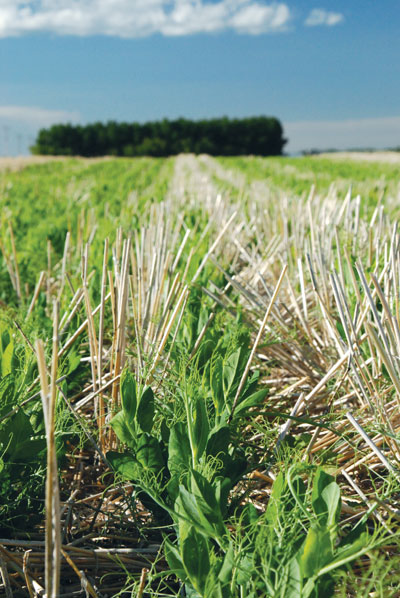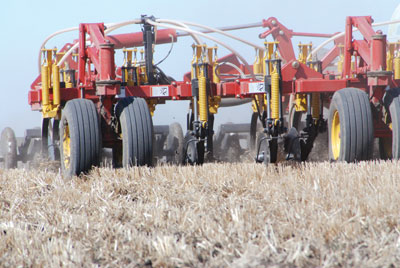
Features
Agronomy
Seeding/Planting
RTK-guided seeding trials to test tall stubble shelter
The concept of seeding between rows of standing stubble, or inter-cropping, is starting to gain some traction. At least four cutting-edge innovators are setting up to seed between the tall rows of standing stubble in the spring 2010 with the aid of RTK precision guidance at sub-inch accuracy.
March 18, 2010 By John Dietz
The concept of seeding between rows of standing stubble, or
inter-cropping, is starting to gain some traction. At least four
cutting-edge innovators are setting up to seed between the tall rows of
standing stubble in the spring 2010 with the aid of RTK precision
guidance at sub-inch accuracy.

|
|
| Using RTK guidance to precisely seed between rows brings added agronomic benefits. (Photos by Bruce Barker) | |

|
|
| RTK seeding can reduce overlaps and improve seeding efficiencies.
|
Even without the RTK, there is already support for the concept.
Agriculture and Agri-Food Canada research centres have encouraging
evidence, and a few growers have been doing their own version of
inter-row seeding since about 2005.
Swift Current, Saskatchewan-area grower John Wright crops 5000 acres of
spring wheat, durum wheat, flax, canola, barley and lentils. He puts in
the crop with a Bourgault 5725 air coulter drill using disc openers on
10-inch spacing and mid-row banding.
For 2010, Wright plans to steer his field operations with sub-inch,
between-the-row accuracy, using a Trimble RTK guidance system for his
autosteer. He also plans to harvest all his cereal crops with a pair of
stripper-headers on his two combines. Oilseeds and pulses will be
harvested with a conventional header, with as much stubble height as
the crop allows.
Trimble’s TrueTracker system includes a GPS receiver and T3 terrain
compensation technology mounted on the implement. It keeps implements
on a repeatable path, year-to-year, even on extremely sloped fields and
variable soils.
Wright needed precision-placed rows, seeded in 2009, as a reference
point for the 2010 effort at inter-row seeding. He followed the
WAAS-guided path from 2008, and was amazed in 2009 as he sprayed new
crops that had been seeded using RTK. “This year, I started with
straight rows. Next year I will be able to seed between the rows,” says
Wright. “This year I learned how inaccurate I was with WAAS and the
eight-inch accuracy it gives. I could see it when I was on the sprayer.
Last year with seed placement I moved back and forth. This year I
seeded straight.”
He estimates that half the time, his RTK-placed seed was between former
rows and half the time it was on the old stubble rows. Seeding into the
old standing stubble was a problem. “Walking through my fields, I found
that when I was seeding between the rows I had very, very even
germination. When I was seeding on the rows, I would start seeing
misses. It showed up after the plants emerged and was very clear.”
He penciled out a cost for that “wandering” with WAAS on 1700 acres of
lentils. His estimate: if he had been perfectly on track for one season
in just the lentils, he could have saved about $5000 in expenses and
losses that could have been applied to his RTK purchase. As well,
Wright believes inter-row seeding will eliminate trouble with
hair-pinning and lead to “absolutely perfect” germination.
Wright has used a single stripper-header for several seasons, and seeds
pulse crops into the stubble. He uses steel discs to slice through crop
residue with minimum soil disturbance and minimum moisture loss.
Already, his agrologist estimates that he gets a three-bushel yield
increase on 26-bushel lentils where he has them sheltered by tall
stubble. If he can keep the system from wandering with RTK, yields may
improve further.
Guidance moved to air drill
Taber, Alberta-area farm manager, Kim Oseen was able to seed about 4500
of his 6000 acres in 2009 with an RTK system. He grows durum, winter
wheat, feed barley, yellow peas and an oilseed like canola, flax or
mustard. He uses a Bourgault air drill with 3/4-inch openers, 10-inch
spacing and mid-row banding. His autosteer uses a Case IH- Trimble RTK
system. “I got it for the accuracy. I’m not sure it was the best
investment, but I did want a little more accuracy,” he says. “I think
eventually I’ll have all my guidance systems on RTK.”
The dryland, no-till farm relies on tall stubble to trap snow and
reduce wind erosion. At seeding time, Oseen would prefer to keep
equipment from drifting over the tall stubble. Ideally, he would like
to seed into bare dirt between stubble rows. “If your seed opener is
going over last year’s stubble rows, you’re tearing that stubble out
and I think, you’re not getting a consistent depth. If you’re directly
between last year’s seed rows, hopefully, you just open that soil and
close it again without straw. That should give better packing,” he
says.
Previously, guidance gear was mounted on the tractor. Now it is mounted
on the air seeder. “The air seeder has its own antenna. From what I
understand, the implement will tell the tractor where to run to keep
the implement between the rows,” says Oseen.
Increased yields with taller stubble
The concept of inter-row seeding into standing stubble has “SPARCed”
interest of researchers at AAFC, Swift Current. “I like the concept of
inter-row seeding,” says Herb Cutforth, agro-meteorologist at SPARC
(Semiarid Prairie Agricultural Research Centre), Swift Current.
Previously, researchers compared crop responses on stubble that was
cultivated and flattened to crop responses when seeding directly into
stubble left standing six and 12 inches tall. No attempt was made to
seed between the stubble rows; the drill wandered across the rows. “We
looked at the response of legumes, peas, canola and wheat to various
heights of wheat stubble. We found a 10 to 15 percent yield increase
with tall stubble over cultivated residue when averaged during four or
five years, without increasing the water use. The majority of the yield
increase was due to changes in the microclimate,” he says.
AAFC researchers on the semiarid Prairies have explored crop response
to different stubble heights for more than 15 years. Research showed
that the taller the stubble, the more shelter there is for the emerging
crop. Wind speed is sharply reduced at ground level and for several
inches above; the reduction is directly related to the height of the
stubble. “Reducing wind speed reduces evaporation from the soil, so
more water is available to the plants for transpiration. Reducing wind
speed alters the energy balance. We found that especially on sunny
days, plants growing in taller stubble often have higher plant
temperature than those growing in cultivated stubble,” Cutforth says.
In more recent trials, a third stubble height (18 to 20 inches tall)
was introduced. The question was, if 12-inch stubble results in a 10 to
15 percent yield increase compared to cultivated stubble, will 18- to
20-inch stubble result in an even greater yield increase?
The preliminary answer after three to four years, Cutforth says, seems
to be that, “If you get good seed-soil contact in the seeding
operation, then the straw that’s a foot-and-a-half tall, over the long
haul, will give a yield advantage greater than that provided by the
12-inch stubble.”
Now, because of increased producer interest in the semiarid prairie for
extending crop rotations using pulse and canola crops, Cutforth and
colleagues are beginning to evaluate inter-row seeding as a means of
conserving stubble during the seeding process.
Tall cereal stubble provides good shelter to growing seedlings, but the
impact of pulse and canola stubble on crop yields and quality in a
rotation needs to be investigated. Pulse crops mostly are harvested
close to the ground leaving little standing stubble, so benefits from
the stubble row are likely minimal.
Canola (a crop gaining popularity in the semiarid prairie) stubble
generally consists of stems that tend to be brittle, thinly populated
and thus, widely spaced compared to cereal stubble. Whether canola
stubble can provide significant wind shelter to affect yield is
unknown, and the interaction of soil, seed and broken and brittle
canola stems could be a problem for inter-row seeding, Cutforth says.
Inter-row seeding into canola stubble would be one way of preserving
standing stubble during seeding, as well as reducing the potential for
plugging, especially for hoe drills. Cutforth says that the inter-row
seeding he is starting now is an attempt to leave as much of that
canola stubble standing as possible. Inter-row seeding on larger trial
plots will begin in 2010.
Straw Track, Inc has provided the centre with a custom-made “research
special,”18-foot air drill equipped with the “SmartHitch,” a
proprietary guidance device for Seedmaster air drills. SmartHitch
employs a pair of discs that sense when the drill is tracking in an
existing furrow or groove and exert pressure on the hitch to prevent
the drill from wandering across stubble rows. SmartHitch has been
available on commercial units since about 2006.